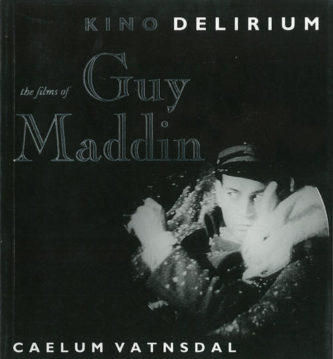 By CAELUM VATNSDAL (Arbeiter Ring Publishing; 2000)
By CAELUM VATNSDAL (Arbeiter Ring Publishing; 2000)
Winnipeg’s Guy Maddin is one of the world’s most individual filmmakers. He specializes in deliberately archaic mock silents with themes that lean toward the macabre and perverse. His films simply don’t play like anyone else’s, and the man himself is every bit as unique.
This is one of the very few books devoted to Maddin and his films. Author Caelum Vatnsadal made the documentary GUY MADDIN: WAITING FOR TWILIGHT, and is evidently a huge fan of his subject, which helps make KINO DELIRIUM a must-read volume for fans. As for those viewers who don’t already know and/or like Maddin’s work…well, I’m not sure this book will do much to induct them. Maddin is a filmmaker whose cinema one either “gets” or doesn’t (there’s no meeting it halfway), and that’s also true of this book.
It consists mostly of a lengthy interview with Maddin about his films. They range from the scrappy 1988 no-budgeter TALES FROM THE GIMLI HOSPITAL to the (slightly) more expensive pictures ARCHANGEL, CAREFUL, TWILIGHT OF THE ICE NYMPHS and the stunning 2000 short THE HEART OF THE WORLD. Yes, Maddin has made several films since then (including 2004’s SADDEST MUSIC IN THE WORLD and ‘08’s MY WINNIPEG, in my view two of his very best features), but this book only goes up to the year of its publication.
It contains many fun tidbits about the making and reception of Maddin’s films, including his recollection of how the Canadian film big shots Atom Egoyan and Jeremy Podeswa were “snobby” to him at a late-eighties Toronto Film Festival, and how TALES FROM THE GIMLI HOSPITAL emerged from a desire to mock Icelandic Canadians, i.e. Maddin’s ancestors (“the banner beneath which I worked on that picture was “Annoy My Family”). On ARCHANGEL Maddin became enamored with the 1930s-era tradition of the “part-talkie,” something he knew “no one else would have the nerve to make” (he was right). CAREFUL was Maddin’s first color film, shot in a fragile “Repress-O-Vision” because of “all the caution in the script.”
Included are several appendices. In one Maddin relates the history of the “Drones,” which is to say his circle of fiends (“In the beginning, before there were photoplays, all was lassitude and sluggishness…we were in college, five or six of us boys, staggering around each other”). Another lists Maddin’s video collection with his comments; included are Wladyslaw Starewicz’s THE CAMERAMAN’S REVENGE (“It’s really odd seeing a lurid love story enacted by dead bugs”), Sam Raimi’s THE QUICK AND THE DEAD (“I love this movie. Go figure”) and Abel Gance’s LA ROUE (“I love directors who were obviously possessed, and Gance was possessed by the greatest case of hubris ever, plus a big cocaine addiction”). Finally, there’s Maddin’s 9-page script for THE HEART OF THE WORLD, which concludes with the stern entreaty “IT MUST BE THIS WAY!” followed by the more contrite “I think I would like to Try it This Way.”
Somehow those two proclamations, taken together, seem (for me) to sum up the lunatic genius of Guy Maddin, of which this enjoyable volume is a terrific sampler. If you’re having trouble fathoming the charms of either, then I’m sorry, but the chances are you’re simply not going to.
